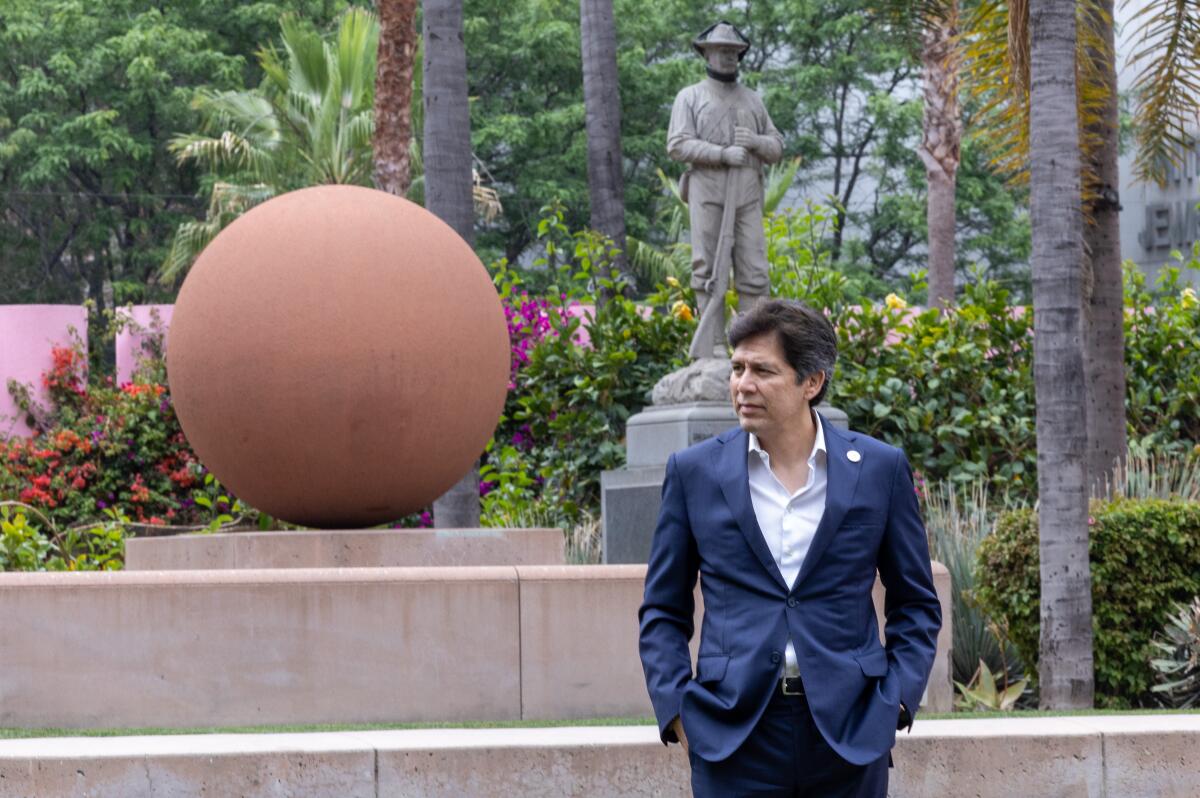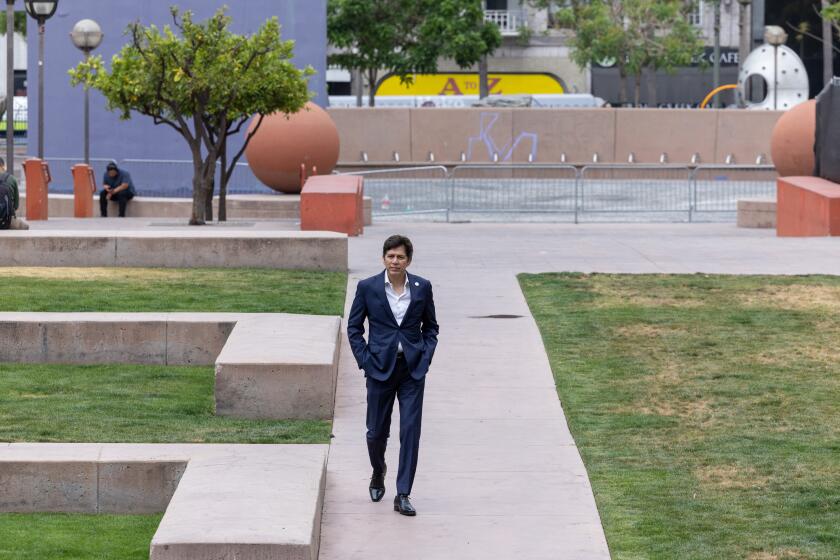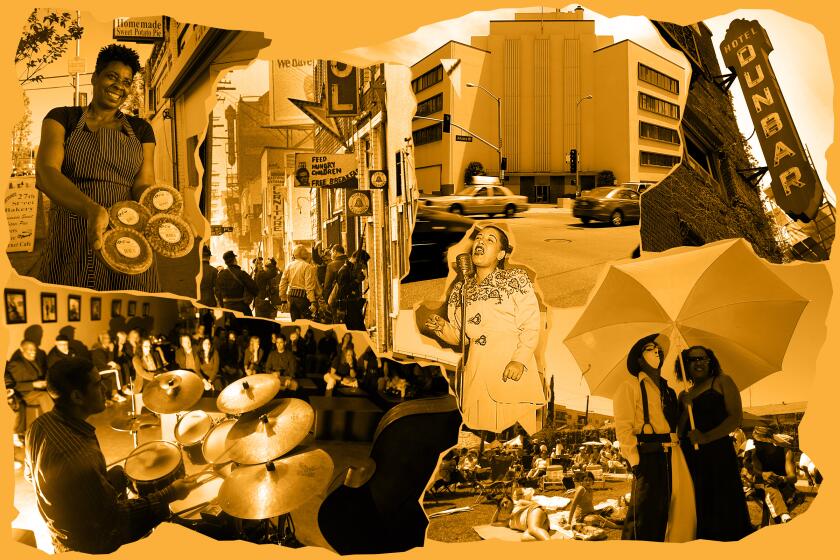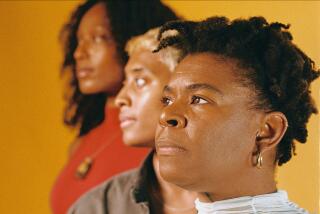Opinion: Kevin de León’s plan to rename Pershing Square is not the way to honor Black Angelenos

- Share via
Los Angeles City Councilmember Kevin de León recently introduced motions to rename Pershing Square after Bridget “Biddy” Mason, who got her freedom from bondage in Los Angeles in the 1850s. His effort to reimagine the long-beleaguered public space, which is undergoing renovations, may be well-intentioned. But it is also disconcerting.
For one thing, Biddy Mason Memorial Park, opened in 1989, already recognizes her accomplishments at her homestead a few blocks northeast of Pershing Square, at Third and Spring streets. Why hasn’t De León considered other worthy Los Angeles Black settlers who owned property and enterprises downtown so that more of the city’s pioneering African Americans could be recognized? Black Angelenos whose stories are less known could be honored at the site.
It seems all too possible that De León is pandering to the Black community, women and others to make up for that infamous racist conversation among city leaders exposed in 2022. Given their redundancy with an existing memorial, his efforts do not seem truly directed at showcasing Los Angeles’ overlooked histories and historical figures.
De León seems to be daring critics to oppose his feel-good Biddy Mason measure.
Take, for instance, Robert and Winnie Owens and their children, Sarah, Martha and Charles, who were also prominent formerly enslaved people and have yet to be appropriately recognized by the city. Robert Owens purchased his and his family’s freedom from bondage, and they migrated from Texas to Los Angeles between 1852 and 1853. The Owens family owned real estate and a livery venture and provided other business services in Los Angeles. By the time the formidable Robert Owens died, in 1865, he was considered the wealthiest African American in Los Angeles County.
This family — along with Los Angeles’ Manuel Pepper and San Bernardino County’s Elizabeth Rowan, both African American, and a few white allies — helped Mason, her children and members of her extended family escape enslavement in 1856. Mason and her children, Ellen, Ann and Harriett, initially lived with the Owens family as newly free people in Los Angeles while forming a relationship with their adopted community. This helped the elder Mason develop her successful midwife practice. She eventually became the first African American woman who was a sole owner of real estate she purchased. Biddy Mason’s daughter Ellen married Charles Owens, merging the two families.
Louis (or Lewis) Green, a barber who held other occupations in his lifetime, is another Black Angeleno pioneer worthy of broader recognition in our civic memory. After he overcame racist subterfuge by white locals, Green became the first African American to register to vote in Los Angeles County in 1870, the year the 15th Amendment extended voting rights to Black men.
Biddy Mason Memorial Park was among the first significant efforts to acknowledge the histories of working people and communities of color in Los Angeles’ public spaces. Created by the nonprofit group the Power of Place, the project was a result of years of historical research, community engagement, collaboration, wrangling over permitting and policy and fighting with dismissive city leaders. Thirty years later, in 2019, when then-Mayor Eric Garcetti convened advisors, historians, cultural critics and designers as the Civic Memory Working Group, the Power of Place initiative remained an important touchstone.
South Central Avenue was once a thriving hub for Black Angelenos. Here’s a look back at an important piece of civic history in L.A.
Yet it seems too easily forgotten. In proposing to rename Pershing Square for Biddy Mason, De León has derided the Memorial Park, which is in his district, as dark and secluded. It’s unclear if or how he intends to fix that.
The city seems to have done little to sustain Biddy Mason Memorial Park. There are no big entrance signs; two small metal plaques on Spring and Third Streets, both defaced, offer no directional guidance. The lighting and seating do not invite visitors to look at the weathered commemorative features, which are overdue for rehabilitation. These include “Biddy Mason’s Time and Place,” designed by Sheila Levrant de Bretteville, a commemorative wall with imprints and artifacts of Mason’s life and times. Adjacent to it is “Biddy Mason: House of the Open Hand,” by the renowned Los Angeles-based African American artist Betye Saar, whose installation offers a glimpse of what Mason’s home looked like based on historical photographs.
The city has long lacked a process and policies for addressing commemorative sites. The Mayor’s Civic Memory Working Group was formed to address this gap. In a 2022 report by the group, then-Chief Design Officer Christopher Hawthorne wrote a “chief lesson” is that “broad-based discussions about memorialization and commemoration” are needed, and that “Los Angeles has not yet engaged in that conversation to the degree it needs to, especially when it comes to initiatives launched from City Hall.”
L.A. needs to reconsider civic memory beyond renaming places, removing statues and creating new commemorative efforts. This requires more comprehensive review and maintenance of past efforts. The report also stresses the need for community involvement, acknowledgment of multilayered histories and a thorough process involving historians, Indigenous leaders and community elders.
De León should join us in calling on his fellow City Council members and Mayor Karen Bass to take the steps clearly laid out by the Civic Memory Working Group to honor Biddy Mason and others like her.
Alison Rose Jefferson is a historian, curator, heritage conservation consultant and the author, most recently, of “Living the California Dream: African American Leisure Sites during the Jim Crow Era.” Catherine Gudis is a professor of history and the director of the public history program at UC Riverside, the scholar in residence at the Los Angeles Poverty Department’s Skid Row History Museum & Archive, and a former member of the Civic Memory Working Group.
More to Read
A cure for the common opinion
Get thought-provoking perspectives with our weekly newsletter.
You may occasionally receive promotional content from the Los Angeles Times.












